Your DMs are blowing up with brand collab opportunities, and you feel pretty stoked. But hold up! Before jumping headfirst into a sea of brand deals, you must understand the role of the unsung hero of any collab––the creator contract.
A contract protects you and ensures you get paid fairly. But don’t simply fill in the blanks of an online template and sign the dotted line. You want to prepare for the best and worst-case scenarios.
Find out what an airtight creator contract looks like and how to build long-lasting brand collabs.
Key takeaways
- Contracts clearly state expectations and keep everyone involved in the collab on track
- They also provide a safety net for creators when collabs go awry
- Creators of all experience levels need a contract––no exceptions
- Brands with an established creator program are likely to provide contracts
- Clear-cut deliverables protect creators from scope creep
- It’s usually best if creators own the rights to content
Contracts serve as your campaign roadmap
Contracts set clear expectations for everyone involved in the collab. They’re a roadmap guiding your journey through the campaign from start to finish. With a contract, both parties understand what to do, when they need to do it, and how they’ll measure success.
A contract also outlines legal matters, such as who owns the content, how to handle disputes, and how to safeguard each party’s interests. They keep everyone on the same page so you can focus on creating a show-stopping campaign together.
In an ideal world, you won’t ever need to use your creator contract, but it’s best to prepare if things go sideways.
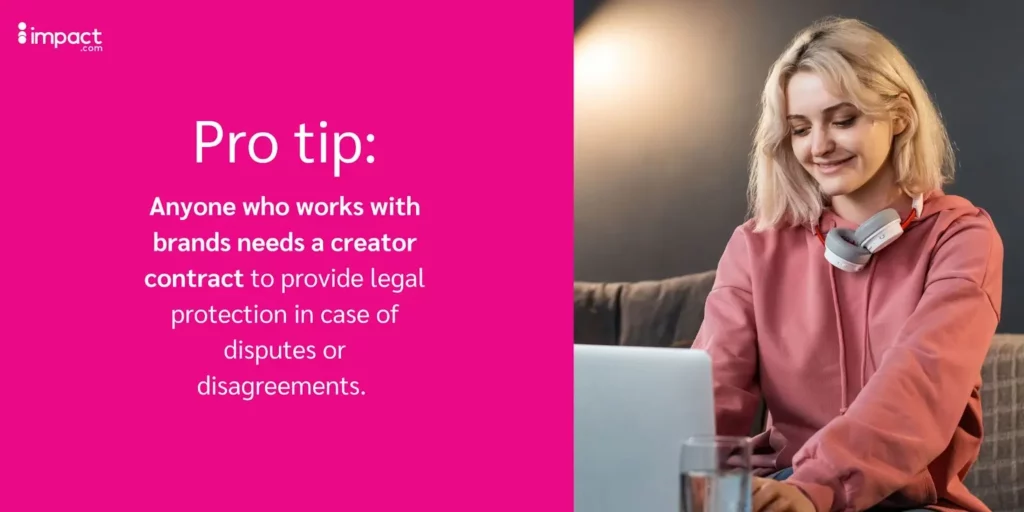
A creator contract is like a dependable friend who’s got your back. It ensures what’s promised is delivered; if not, you have a written record to fall back on. It’s a handy protection against scope creep, late payments, and even legal disputes.
Maybe a beauty brand suddenly decides they want three extra posts for the same price or delays a payment you were relying on. Now, you have a record of what you were supposed to deliver to the brand and when they were supposed to pay you.
In their enthusiasm to kick off a collab, newer creators sometimes overlook contracts––they may seem unnecessary. However, contracts set the project up for success and define expectations for both parties.
4 options for sourcing creator contracts
Contracts must consider the brand’s and your unique requirements along with the type of collab. The best place to source a contract depends on your budget, the complexity of the collab, and the kind of brand you’re working with.
Here are four places to find content creator contacts:
1. Download a template online
Online platforms such as Bonsai, Rocket Lawyer, and LegalZoom have customizable contract templates for download. Remember, a template is a starting point––you must tailor them to your specific needs.
- Pros: Quick, easy, and budget-friendly.
- Cons: It might be too generic and not cover specific needs.
Online templates are often better for freelancers with simpler needs than creators.
2. Receive contracts from brands
Brands may want to use in-house creator contracts if they already have an established influencer program. You’ll need to review carefully and negotiate terms with the brand.
- Pros: Created by people who know the brand and its needs best.
- Cons: May favor the brand over the creator.
In-house creator contracts work best for creators who are part of a larger creator cohort working on the same campaign. These contracts consider the brand’s unique requirements and ensure uniformity across collabs.
3. Create a bespoke contract with a lawyer’s help
A local law firm can prepare a solid base contract for you. Then, you can tweak it for different collabs, giving you control over the scope of work and payment terms.
- Pros: Tailored to your specific needs.
- Cons: A more expensive way to draft a contract.
Bespoke contracts are best for creators with complex deliverables and agreements. They may need specialist legal advice to help them draft a contract.
4. Negotiate your contract through a partnership platform
Partnership platforms like impact.com / creator make contract negotiation easy. Using impact.com / creator, brands propose a statement of work and creators can find, manage, and amend these terms within one platform.
- Pros: Centralize and streamline the contract process on one unified platform.
- Cons: There may be subscription costs or one-off fees.
Partnership platforms work well for creators of all experience levels and collab needs. Negotiating contracts with brands within the platform is easy without the legal fees or multiple templates.
Want to see more? Check out our PXA course on contracts and payments to make negotiating terms easier with impact.com / creator.
7 can’t-miss sections to have in your contract
Whether you’re sending your own contract or signing one written by the brand, the fundamental elements remain the same.
Here are seven points your content creator contract must include.
1. Create clear-cut deliverables
Are you creating three unboxing TikToks, two Outfit of the Day Reels, and one seasonal YouTube video guide? Get specific about the content format and deliverables. No one likes those vague “wait, I thought you’d also…” moments.
Other than content format, also include:
- Length of each video or audio clip. If it’s a Reel, it’s likely to be seconds, while a YouTube video will be minutes.
- Visuals you’ll need from the brand to kick off the collab. These might include logos, branded filters, product features, or video clips.
- Script requirements. Do you need to mention specific features or products? Do you have to be honest or only say what you like about the brand? Some brands give creators free rein, while others provide a script.
The most successful collabs start with understanding what the brand expects you to deliver. Defining projects in writing protects you from dreaded scope creep.
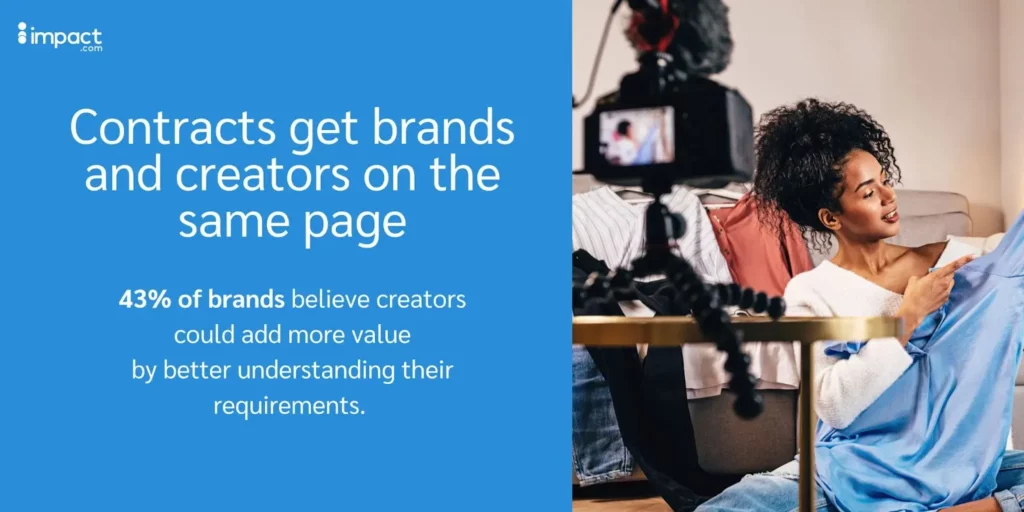
Source: Aligning marketers and influencers: Shifting perspectives on influencer marketing across the funnel
2. Define deadlines and the revision process
Your contract should have clear dates. A solid roadmap prevents any detours or delays.
Every client has a deadline or milestone. Your contract should include these so everyone knows what to expect.
Outline key milestone dates:
- Kick-off date. When the collaboration officially begins, whether it’s a pre-collab prep or brainstorming sesh.
- Content draft deadlines. This isn’t just when the final piece is due; perhaps you have initial drafts or stages. When should the storyboard be ready if you’re working on a video? When is the rough cut due?
- Feedback windows. Set a specific timeframe for the brand to provide feedback. Give them 48 or 72 hours, so you’re not left hanging.
- Final content submission. This is when the polished, finished content must be in the brand’s hands.
- Publication date. The moment of glory. When is the content going live? Whether it’s a blog post, video, or social media update, it’s good to have this locked in.
We all wish for love-at-first-sight content, but let’s be honest––edits are part of the game.
Always be upfront about edits and set some limits. One or two rounds are standard.
Minor edits? Sure thing. A complete overhaul? You might need a chat (and another payment). Make sure the brand knows the difference to prevent endless back-and-forths that drain your creative spirit.
Setting these boundaries in your written agreement protects your time and keeps everything running smoothly.
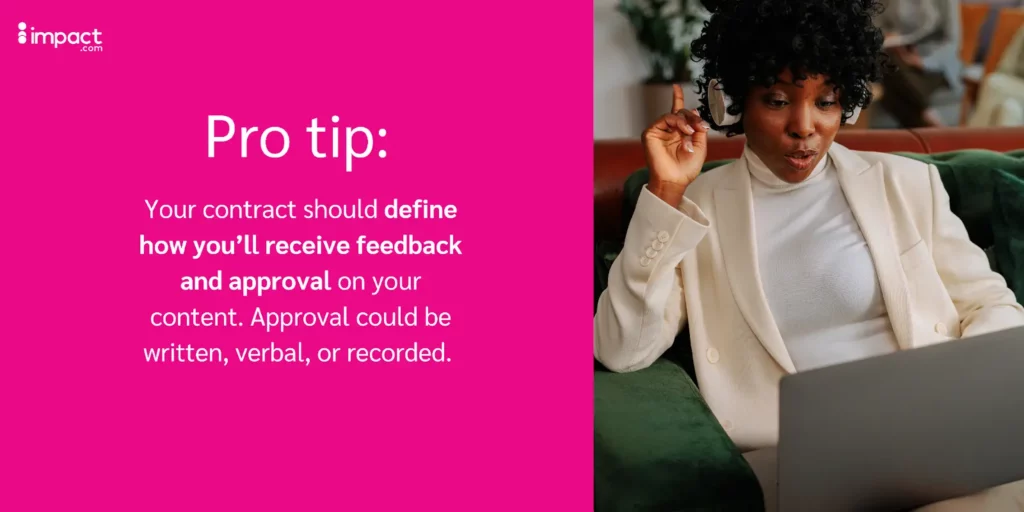
3. Set payment terms
Outline your fees, payment terms, and––just in case––late payment penalties. Don’t leave anyone guessing when or how your bank account will glow up.
Defined payment terms should include:
- Date of payment. When is payment due? Upon receipt of approved content? Within 30 days of receipt?
- Extra work means extra pay. Sometimes, brands want a little extra sparkle. How will it affect the price tag if they ask for more? It’s like ordering a pizza and deciding you want extra toppings—you must pay up!
- Flat fee vs. milestones. Choose a one-off payment for the whole project or break it down into milestones. Lay it out so there’s no guesswork.
- Payment methods. Will you get paid via bank transfer, PayPal, or credit card? Ensure you and the brand are cool with how the cash flows.
- Refund policies. If a brand decides they don’t want to work together halfway through the production process, what’s your approach? Do you ask for a kill fee of 50 percent, payment in full, or give them a refund?
- Payment timeline. If you expect payment within 30 days of invoicing, say it.
- Late payment protocols. Fingers crossed, you’ll never need this, but always prepare. If a payment is late, will there be a fee? How will you handle reminders? Having this in writing helps dodge any awkward “um, you owe me” conversations.
With these details in your contract, you’re setting up a transparent and fair collaboration for all parties.
4. Determine who owns the content
Always define who gets the keys to the content castle post-collab. Can the brand use your content after the campaign wraps? For how long? Are they going to pay extra for the privilege?
Here’s what to specify in the contract’s intellectual property rights (IP) section:
- Ownership. Who owns the content? Is it you or the brand?
- License to use. Maybe you own the content, but you’re giving the brand permission (AKA a license) to use it. Define for how long and in what mediums. Like granting a VIP backstage pass, show where they can go and where’s off-limits.
- Repurposing and editing. Can the brand add their flair to your video? Set those boundaries upfront so your content doesn’t morph into something unrecognizable.
- Promotion and pitching. Agree on whether you can use the content for personal promotion and pitching.
- Duration of use. Can the brand use your content for a month? A year? Eternally?
- Reselling or transferring rights. Here’s a twist––can the brand sell or transfer the rights to your content to someone else? Ensure you’re comfortable with where and with whom your content may end up.
Usually, it’s simplest if the content creator owns the copyrights to the work. Why? You’re in control of where your content ends up.
If you assign the rights to the brand, it’s best practice to:
- Assign the final product, not the drafts, so the brand can’t use or modify them.
- Make ownership conditional on payment––if they don’t pay, they don’t receive the rights.
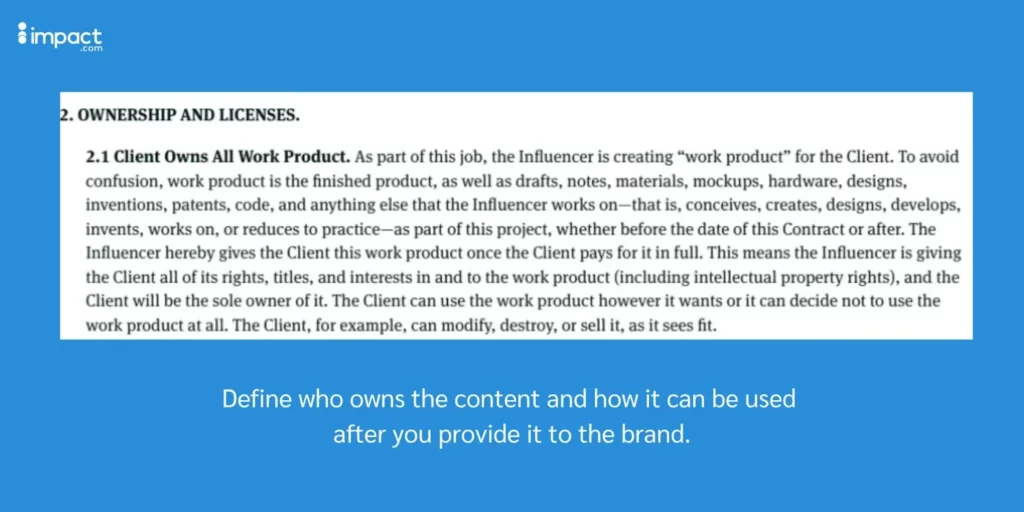
Source: Bonsai
5. Spell out any exclusivity clauses
Are you in a monogamous brand relationship? If so, for how long? Your contract should spell out if and when you can collab with other brands––especially competitors.
Exclusivity clauses define whether you can work with competing brands or not. They often appear in traditional content creation contracts. A non-exclusivity clause guarantees you’re not in a limiting relationship with one client.
Most traditional creators usually collab with multiple clients. So, it’s essential to define the list of competitors and the period so you don’t have limited earning potential. If you’re a brand ambassador, expect stricter guidelines around working with competitors.
Generally, creators can enter exclusivity agreements without worry. The exception is if you’re a UGC creator. A non-compete agreement can hold you back from creating content for other brands in your niche.
6. Outline any confidentiality clauses
Confidentiality clauses ensure no spoilers ruin the show. You build trust with the brand by providing clear confidentiality terms.
Confidentiality clauses define what a creator can and can’t share about the partnership. Some brands may not allow you to discuss the collaboration at all. They may ask you to sign a non-disclosure agreement (NDA).
Confidentiality clauses need to outline the following:
- What’s under wraps. Upcoming product launches, brand strategies, or perhaps some secret sauce ingredients? State what info should stay private.
- Duration of the agreement. Some secrets must stay under wraps forever (like the Krabby Patty formula), while others might only be sensitive until a product launch or campaign release.
- Consequences of breaking the pact. If secrets spill, what happens next? Is there a penalty? A formal apology? An obligation to fix any resulting mess? Make sure you know the cleanup policy and if there are legal consequences.
- Third-party sharing. You might need to share confidential details with team members, freelancers, or partners to complete the job. The contract should specify these details and get a thumbs up from everyone regarding secrecy.
- Campaign promotion. Can you share news of your collaboration with your followers? Check if this is allowed and if you can share details during or after the collab.
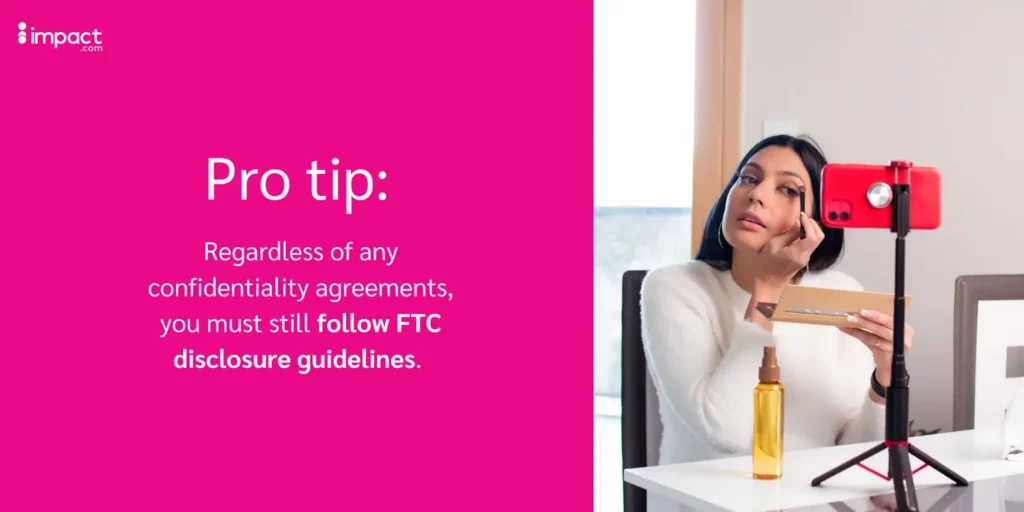
Source: FTC disclosure guidelines
7. Establish the grounds for termination of the partnership
Nobody likes a messy breakup. Outline what happens if either party wants to call it quits early. Mark the exit door from notice periods to refund conditions, so everyone knows how to get out of the contract politely.
To avoid being caught off guard, here’s what you need in the termination section:
- The ‘why’. What warrants a contract termination? Non-payment? Failure to deliver? Maybe it’s just a mutual feeling of “this isn’t working out”? Define what actions (or lack thereof) can lead to a break.
- Notice period. If either party wants to pull the plug, clarify how much heads-up is required. Set a timeframe to allow a relatively smooth exit, whether it’s 30 days, two weeks, or even 72 hours.
- Final finances. If you end a collab early, specify if there’s a partial payment for work done or a cancellation fee.
- Post-termination duties. Even if the contract’s over, there may be lingering tasks––such as returning provided materials or deleting sensitive data. Outline any post-breakup responsibilities.
- Protection from ghosting. Include a clause that prevents either party from vanishing without a word. Keeping communication lines open, even in termination, is key.
- Dispute resolution. Sometimes, it’s not a clean break. If there’s a disagreement about the termination, how will it be resolved? Mediation, arbitration, or a court battle? Hopefully, you’ll never need it, but being prepared helps.
While we all hope for long and prosperous partnerships, understanding your termination terms ensures a fair and drama-free exit.
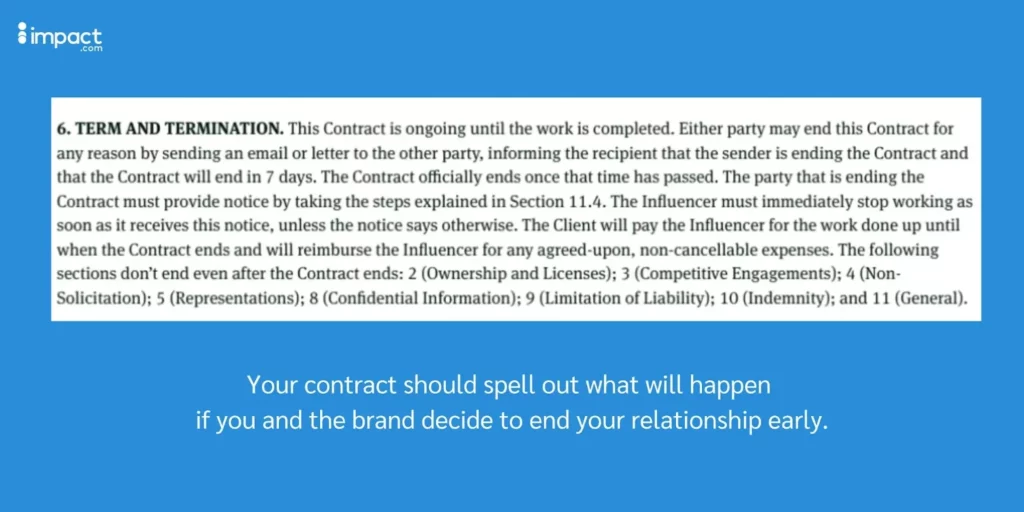
Source: Bonsai
Content creator contracts form the backbone of successful collabs
Creators who protect themselves with watertight contracts have the best chance of building long-term, successful brand collabs. Decide which terms you can accept and which you won’t.
Start by reviewing contract samples and templates. Then, find brands looking for partnerships that match your expectations.
Use a platform like impact.com / creator to find like-minded brands, communicate with them, negotiate contracts, and handle payments.
Want to manage your brand collabs in one place? Sign up for impact.com / creator to discover brands ready to partner with creators like you.
Keep learning with these additional resources:
- 5 research-backed ways creators can stand out when pitching brands (blog)
- 4 research-backed ways content creators can increase buyer intent (blog)
- How much do influencers charge per post in 2023? (blog)
FAQs
Brands will often provide the creator with a contract and the creator must review and negotiate the terms. Alternatively, creators draft their contracts with clear terms to protect their interests when working with brands.
It’s always good to have a sample or template on hand. You should also know which terms you are and aren’t okay with. Seek legal advice to confirm your contracts are comprehensive and legally sound.
New content creators should use contracts when they collab with a brand. No matter how new you are to content creation, a contract sets expectations and protects your best interests.
While many content creators are independent contractors, they have special considerations other freelancers may not have.
Don’t use a generic agreement template and instead customize a proper creator contract template. Or use a partnership platform like impact.com / creator to handle contracts for you.






